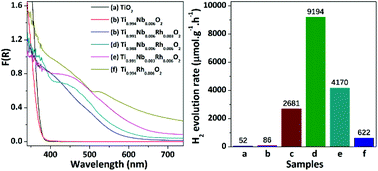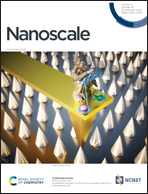Effect of Rh valence state and doping concentration on the structure and photocatalytic H2 evolution in (Nb,Rh) codoped TiO2 nanorods†
Abstract
The simultaneous realization of visible light response and high photocatalytic activity remains a challenging task for TiO2 despite extensive research. Herein, (Nb,Rh) codoping is adopted to extend the absorption band of anatase TiO2 into the visible-light region. Meanwhile, the dependence of the electronic structure, visible-light absorption, and photocatalytic performance on the dopant ratio as well as doping concentration is studied. Open shell t2g5 Rh(IV) and closed shell t2g6 Rh(III) coexist in Rh-doped TiO2, and the codoped Nb promotes a change in valence state from Rh(IV) to Rh(III). Rh(III) is the main active species in charge of the excellent photocatalytic performance, while Rh(IV) doping introduces electron/hole recombination centres. However, surprisingly, a trace of Rh(IV)-doping contributes to a decrease in electron transfer resistance and an increase in donor density, which help to improve photocatalytic performance. By virtue of the controlled content of Rh(III) and Rh(IV), Ti1−2xNbxRhxO2 exhibits a high hydrogen evolution rate of ∼9000 μmol g−1 h−1 in methanol solution, along with a remarkable photocurrent density of ∼9 μA cm−2 under visible-light irradiation, which are about 170 and 30 times higher than those of pristine TiO2 nanorods, respectively.

- This article is part of the themed collection: Celebrating 60 years of the Fujian Institute of Research on the Structure of Matter


 Please wait while we load your content...
Please wait while we load your content...